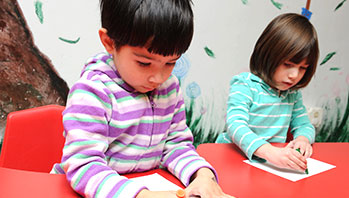- crayons
- markers
- paper
- pictures of different environments
- character
- setting
MA Standards:
Foundational Skills: RF.PK.MA.1 With guidance and support, demonstrate understanding of the organization and basic features of printed and written text: books, words, letters, and the alphabet.
Writing: W.PK.MA.3 Use a combination of dictating and drawing to tell a real or imagined story.
Head Start Outcomes:
Literacy Knowledge/Early Writing Recognizes that writing is a way of communicating for a variety of purposes, such as giving information, sharing stories, or giving an opinion.
Literacy Knowledge/Early Writing Uses scribbles, shapes, pictures, and letters to represent objects, stories, experiences, or ideas.
PreK Learning Guidelines:
English Language Arts/Composition 16 Use their own words or illustrations to describe their experiences, tell imaginative stories, or communicate information about a topic of interest.
English Language Arts/Composition 17 Add details or make changes to published or class-made stories.
Draw and Write Together: “Our Three Little Pigs” #1

© Commonwealth of Massachusetts, Department of Early Education and Care (Jennifer Waddell photographer). All rights reserved.
ELA Focus Skills: Concepts of Print, Sequencing, Story Elements (Setting), Story Structure
Educator Prep: Plan out and write the parts of the story on separate sheets of paper before beginning the activity. Have them ready to record children’s details as they dictate.
Talk about different versions of The Three Little Pigs. Discuss how people all over the world know the story, but parts of the story may be different because not every version has the same details. Say, In the Between the Lions show we saw, the three pigs lived happily ever after. But in the book, there was only one little pig left who lived happily ever after. Explain that it is up to the author or the person telling the story to decide what will happen in the story.
Tell children you want them to be authors and to write a new version of The Three Little Pigs with you. Explain to children that they will create details for the story and you will write them down. Choose a few main points and write them on separate sheets of paper so you can assemble in a book when the story is finished. Let children supply the details for each point. For example,
- For pages 1–2, have children choose a new setting. For example, write on the sheet, Once upon a time, there were three little pigs and they lived <have children agree on a setting>. You may want to have pictures of different environments on display: mountains in snow, rain forest with lots of animals/plants, city with lots of buildings, etc.
- For pages 2–4, have children offer new materials to build with. For example, write on the sheet, Each pig wanted to build a house, so they set out looking for something to build with. Have children agree on three different materials. They can be silly materials. For example: met a man selling ice blocks, met a beaver carrying branches, met a gardener selling flower pots . . . .> So the first pig asked the <man> to give him <some ice blocks> to build a house. The second pig, etc.
Other ideas for details to have children supply,
- a new character/action for the villain (dog/barks the house in; mouse/nibbles the house in, etc.)
- a new plot (the wolf and pigs became friends; the pigs tried to blow down the wolf’s house, etc.)
- a new ending for the story
Once the story is finished, title it “Our Three Little Pigs” and have children illustrate each page of the story. This activity will take more than one sitting, plan on extending it to two or three activity times.
Take It Further: You may want to give each child a photocopy of the finished story to illustrate so children have their own versions. Title it “My Three Little Pigs.”
